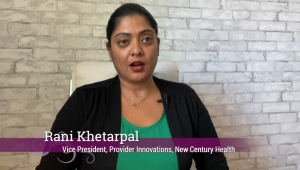As the treatment landscape in oncology changes on a seemingly daily basis, providers face increasingly complex decisions, and it is not just the myriad of therapies available: oncologists must balance drug efficacy and toxicity, clinical outcomes, and patient quality of life, all while providing value-based care. Enter clinical pathways, a multidisciplinary management tool used to guide evidence-based care for subgroups of patients with predictable clinical courses.
Guidelines Versus Pathways
At the 2019 ASCO Quality Care Symposium, Linda D. Bosserman, MD, FACP, FASCO, Clinical Assistant Professor, Medical Oncology and Hematology, City of Hope Medical Group, Rancho Cucamonga, CA, outlined the differences between guidelines and pathways, and discussed how the latter provide an opportunity to ensure high-value interventions while delivering personalized precision medicine.
“Whereas guidelines frequently offer multiple recommendations, clinical pathways translate guidelines or evidence into local structures that aim to delineate the single best option inclusive of drug dosing, time frame, and sequence,” she said.
According to Dr Bosserman, the National Comprehensive Cancer Network produces the de facto US national oncology guidelines, which encompass the breadth of treatment for all patients with cancer, including supportive care, treatment, genomics, and multidisciplinary approaches. When it comes to individual patient needs, however, pathways offer a more personalized approach, incorporating shared decision-making and the patient voice.
“Guidelines offer all possible scenarios, while pathways comprise the details,” said Dr Bosserman, emphasizing that this is still an evolving field. “The whole objective is to facilitate quality care in all aspects of the patient interaction, including their evaluation, prevention, treatment, education, supportive care, and end-of-life. Nevertheless, there’s still some mixing of definitions across the spectrum.”
Although pathways are a great resource for providers, Dr Bosserman suggested, they are not exactly plug-and-play devices. Pathway development should be driven by experts and reflect stakeholder input. Pathways also demand transparency. They need to be evidence-based and clinically driven, promoting patient involvement in clinical trials. Furthermore, once developed, pathways must be integrated into the workflow. They need to delineate clear and expected outcomes and require patient engagement and education.
Delivering Value: The City of Hope Experience
“If you’re going to implement pathways and hold physicians accountable, they need to be integrated,” Dr Bosserman explained. “Cost-effective technology decision support and processes for communication and adjudication are essential, because a significant number of patients in the cancers that we treat will not be on pathway, or the choice for that patient may be better done off pathway.”
In addition, analytics—efficient and public reporting on performance metrics—are needed to promote research and continuous improvement. At City of Hope, the goal is to expand access to leading-edge therapy and clinical trials, while moving to a completely value-based care delivery system.
“In addition to being a National Cancer Institute–designated cancer center, City of Hope has grown to 31 network sites and 5 other major cancer centers across Southern California,” said Dr Bosserman. “With the potential to affect 20 million lives in our region alone, our pathway system must provide decision support at the bedside, while enabling us to analyze and benchmark what we’re doing. We need real-time supportive care for therapeutics and tools that are fully integrated.”
Incorporating pathways, however, poses significant challenges. Standardizing criteria for a single line of treatment is one thing, said Dr Bosserman, but doing so for the third or fourth line of therapy for patients who are living 10 to 12 years out from diagnosis and want additional treatment requires significant work.
“Representing multiple lines of therapy and incorporating that into decision support is an ongoing challenge. We currently look at efficacy, safety, and cost, but sometimes the efficacy is a 1% difference at a very significant cost,” she said.
“Patients will often choose a far lower copay or fewer visits for a very small difference in efficacy, so how we communicate that trade-off to the patient is essential if we’re going to involve them in shared decision-making,” Dr Bosserman added.
As electronic health records incorporate big data, the use of real-world data at the bedside presents an opportunity to understand patients’ perspective on cost. Big data can provide insights, but the electronic record must still capture diagnosis, genomics, and sequencing of treatment. At City of Hope, Dr Bosserman and colleagues are still debating the common data set of elements that started with cancer staging and have now integrated M-Codes.
“Ultimately, we want to offer decision support at the bedside, giving patients all their therapeutic options, along with survival rates and toxicity information, in a way that they can relate,” Dr Bosserman said. “How many visits will their treatment require, and what will be their copay and care issues? This is what our patients want, and I think working together and learning together, we can do that,” she concluded.


